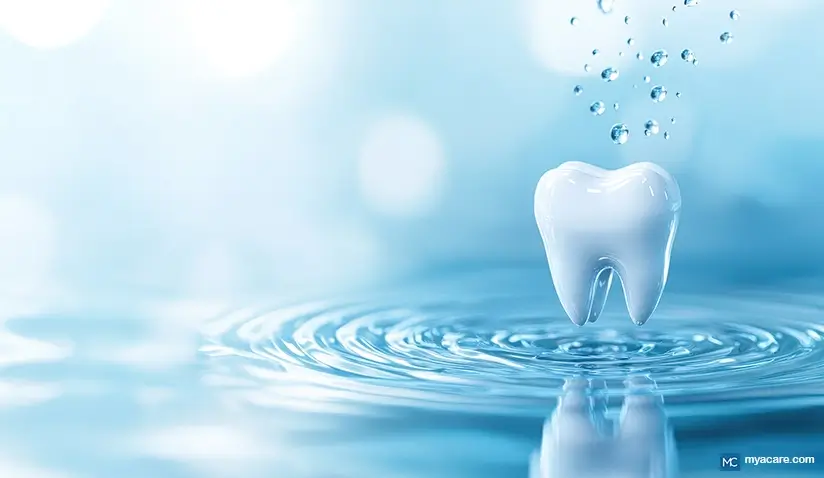Swimming and Dental Health: Possible Side Effects and Prevention

Swimming is one of the best activities for recreation and workout. While most of us know about its health benefits, few are aware of effects it can have on our body, including teeth. In this article, we explain the effects of swimming in public swimming pools on teeth and how you can protect your teeth.
Individuals who swim regularly for longer durations (more than 6 hours per week) in swimming pools expose their teeth to large quantities of chemically-treated water (treated with chlorine). This can lead to dental erosion, increased deposition of calculus (tartar) on the surface of teeth, and external staining of teeth. This condition is known as “swimmer’s mouth.” Research suggests these changes are evident within 21-27 days of exposure to chemically-treated pool. However, playing in the pool, floating, or any other pool activities rarely show any effects on oral health. Details of each of the effects are discussed below.
Dental Erosion
Demineralization of outer layers of teeth (enamel and dentin) due to acids without involvement of microorganisms is known as dental erosion. It is most commonly caused by factors such as food, vomiting, gastroesophageal reflux, medication, and lifestyle habits. Lately, swimming for longer durations has been reported to cause dental erosion.
Epidemiology: Research suggests that 15% of regular swimmers and 3% of occasional swimmers develop dental erosion.
Signs and symptoms: Swimmers usually complain of hypersensitivity of teeth during intake of food or drinks that is cold or citrus. The teeth surface becomes rough and develops depressions with smooth or jagged enamel margins. Yellowish discoloration of teeth may also be observed due to loss of enamel exposing the dentin (inner layer of tooth).
Teeth affected: The upper and lower front teeth are most commonly affected. Regular swimmers’ front teeth erode on outer and inner surfaces. In occasional swimmers, these changes are observed on the inner surface of front teeth.
Causes:
- Acidic pH of swimming pool: To keep swimming pools germ free, chlorine is added in the pools through gas chlorination, sodium hypochlorite, granular chlorine (dichloroisocyanuric acid or dichlor), or chlorine tablet (trichloroisocyanuric acid or trichlor). The use of gas chlorination is the preferred way of treating large pools (~160,000 liters of water) due to its cost effectiveness. Meanwhile, smaller pools use sodium hypochlorite, granular chlorine, and chlorine tablets. The addition of chlorine not only acts as a disinfectant but also adjusts the pH of the pool. Here are factors responsible for lowering the pH of the swimming pool:
- Use of gas chlorination method: The use of gas chlorination method releases excess acid in the water (Cl2 + H2O = HOCl + HCl) which needs to be balanced by addition of soda ash (Sodium carbonate). The addition of insufficient quantities of soda ash can lower the pH. Research suggests that pH less than 5.5 can dissolve the outer enamel layer present on the tooth surface.
- Excess use of chlorine tablet: The use of chlorine tablets releases cyanuric acid as residue. Cyanuric acid is known to stabilize the chlorine and increase its shelf life in water. However, excessive addition of chlorine tablet can increase the accumulation of residual cyanuric acid, turning the pool acidic and lowering its pH. This causes erosion of enamel present on tooth surface.
- Undersaturation of ions in water: Even in pool water with neutral pH, some level of dissolution of surface layer of teeth is observed. This is due to undersaturation of water with ions such as calcium and phosphate which causes leaching out of mineral content from surfaces of teeth.
Increased Calculus Deposition (Swimmer’s Calculus):
Deposition of the hard film of tartar on the surface of teeth is known as swimmer’s calculus. The chlorine (acidic solution) when combined with water in the pool, forms acids which enable the deposition of film-like residue on surfaces of teeth.
Signs and symptoms: Calculus appears as yellow to dark brown calcified deposits.
Teeth involved: Calculus is mainly located on outer and inner surfaces of front teeth.
Cause
-
Presence of antimicrobials: The use of chemical disinfectants in the pool increases the pH of water. If the pH of water in the pool is higher than the saliva in the mouth, the difference in pH causes easy breakdown of proteins present in saliva which deposit on the swimmer’s teeth. This appears as a hard-calcified deposit with black-brown stains.
Staining of Teeth:
Presence of black-brown stains is common in swimmers. These are located on the outer and inner surfaces of anterior teeth. They are also formed from deposition of organic material due to breakdown of salivary proteins (owing to the difference in pH of saliva and water). These stains are difficult to remove using traditional brushing techniques and resemble stains reported with long term use of chlorhexidine mouthwash. Research suggests these stains are also present with gingival inflammation (gingivitis).
Treatment: The following treatments can be considered:
Dental erosion:
- A desensitizing paste can be used to overcome mild amount of sensitivity arising from dental erosion.
- In cases of dentin hypersensitivity due to loss of tooth structure, restoring the surface using tooth-colored resin cements (composites) can be effective. In severe cases of tooth discoloration, veneers and crowns are advised.
- Application of fluoride varnish on the surface of teeth enhances remineralization of teeth and decreases dissolution of enamel surface.
Tips to Prevent Side Effects on Teeth:
Maintenance of the pool:
- Chlorine available in the pool is effective against microorganisms. Other than its effect on microorganisms, chlorine also breaks down the sweat, urine, dirt from swimmers’ body which decreases the concentration of the chlorine in the pool. Hence chlorine concentration and pH should be evaluated twice daily. The concentration of the chlorine in pool should be maintained within the range of 0.3-0.6 per liter (as per European Union regulation) or 2-3 ppm.
- The pH value of water in the pool should be regularly evaluated. If the pH value is above 8, chlorine’s ability to kill microorganisms decreases. Meanwhile, the pH of less than 7 causes irritation to eye and dental erosion. So, the water in the pool should be maintained at the pH of 7.2-7.8.
- Use of alternative methods such as UV light, hydrogen peroxide, ozonates, and bromine instead of chlorine can avoid the side effects.
Protection of Teeth
- Use a pH indicator strip in water to evaluate the pH of the water in public pools.
- Observe the side railings and pool surfaces. The presence of staining or rusting of these areas indicate water in the pool is acidic.
- Use of customized mouthguards are recommended for professional swimmers.
- Rinsing of mouth with water or fluoride-based mouthwash immediately after every practice session prevents the risk of erosion of teeth.
- Learning appropriate breathing system that minimizes frequent mouth openings and reduces the exposure to water while swimming is beneficial for frequent or competitive swimmers.
- Brushing teeth using a soft brush and a fluoridated toothpaste is recommended 30-60 minutes after swimming. The use of fluoridated toothpaste helps in the remineralization (rebuild the mineral content) of teeth.
- Brushing teeth immediately after swimming accelerates the process of demineralization of teeth due to exposure to acids in the pool.
- Use of electric toothbrushes decrease the accumulation of stains and deposit buildup.
To search for the best healthcare providers offering dentistry, please use our search engine. We currently have providers in India, Malaysia, Singapore, Spain, Thailand, Turkey, the UAE, the UK and the United States

Dr. Shilpy Bhandari is an experienced dental surgeon, with specialization in periodontics and implantology. She received her graduate and postgraduate education from Rajiv Gandhi University of Health Sciences in India. Besides her private practice, she enjoys writing on medical topics. She is also interested in evidence-based academic writing and has published several articles in international journals.
Sources:
Featured Blogs



